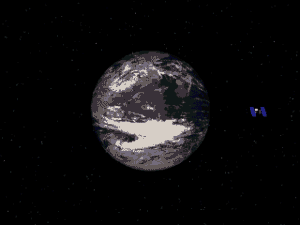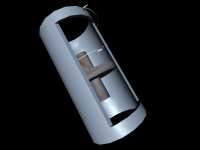


![]() Is angular momentum conserved?
Is angular momentum conserved?
![]()
Since we can define angular momentum in terms of linear momentum times a distance, it seems sensible that angular momentum is also conserved. Indeed the same considerations that are made in deducing the conservation of linear momentum (equal action and reaction forces in a system where there are only internal forces) can be used to show that angular momentum is also conserved. In fact, in any general system both linear and angular momentum are conserved separately and we should not get the two mixed up.
Hence,
the total angular momentum of a system is constant unless an external torque acts on it
However, because velocity is something which has a direction as well as a magnitude, we have to specify a direction when we apply the conservation rule for linear momentum. For the latter this is usually a direction in which there is a component of the velocity, either before or after any internal interaction (such as a collision). It is certainly the case that the before and after velocity will define a plane and that any direction selected for conservation of momentum will be in that plane.
But for angular motion (in which the velocity, though not necessarily the speed, has to change by virtue of the change in direction), a plane is already defined and it makes no sense to select a direction in that plane since it is not uniquely defined. The direction for the angular momentum is therefore taken as being perpendicular to the plane containing the motion.
We will now apply some of these ideas to XMM.
What has torque to do with the pointing of the XMM telescope?
The fact that angular momentum defines a direction, and that angular momentum is conserved provided no external torques are applied, is very useful for a telescope which requires to be pointed at the object being observed for long enough for a good, non-blurred image to be obtained.
Let's consider the simplest of situations. When our telescope is injected into its orbit, let it be spun up (see later) about an axis, say about its optical axis. This axis now defines a direction in space and will remain unchanged provided that no external torques come into play. Hence the telescope stays pointed in that direction.

This image shows a sattelite that stays facing in the same direction throughout it's orbit. It does not fly around the Earth.
It is not actually necessary for the telescope to be spinning; so long as it is stationary and pointing in this direction it will still remain so. (It is a common misconception that the space shuttle flies around its orbit like an aircraft with, say, its base always pointing to the Earth).
The advantage of having a body spinning is that it will then take a larger torque to change its direction had it not been spinning. In orbit there are so-called "disturbing torques" which occur naturally (remember that these are just forces which act on the system in a direction not through its centre of mass). They are external to the satellite system. These are such things as magnetic fields, aerodynamic drag, solar radiation pressure, gravitational field gradients and solar wind particles. Clearly the further away the satellite is from the Earth the smaller these get. For a telescope (or any satellite) in low Earth orbit (typically at an altitude of 500 km) these disturbing torques need to be corrected. How can this be done?
Consider the situation where a disturbing torque is aligned such that it is simply causing the telescope to spin more and more slowly about its optical axis (the torque is taking angular momentum away from the system). If we had a small electric motor driving a wheel (called a reaction wheel, or a momentum wheel) with its axle aligned to the optical axis of the telescope then as the wheel is spun up by the motor it pushes (or reacts against) the telescope causing the telescope to move in the opposite direction. There is no net change in angular momentum in the telescope because the motor torques are internal; the magnitude of the angular momentum in the wheel is equal to that induced into the telescope but in the opposite direction.
By spinning the wheel in the right direction we can restore the spin of the telescope but we can only carry on doing this provided we have spinning capacity in the wheel (and such wheels have a specified upper limit to how fast they can be spun). At this point we can only restore the spin rate of the telescope by spinning the telescope up with an external torque. We can do this with a thruster, for example, attached to the side of the telescope. A thruster is a small rocket which emits a cold gas under pressure. However, if we think about it, what we really need are two thrusters mounted on opposite sides of the telescope so that we apply a couple rather than a torque. This ensures that only the angular momentum of rotation is imparted without any linear motion (see earlier).

This animation is an example of how a spinning wheel can be used to restore angular momentum to a spinning sattelite.
Please move mouse over image
In fact what is done is to put in more than we immediately need so that we can reduce the rotation in the reaction wheel so that it comes back into its effective operational range. This process is called momentum dumping.
If you think about it, throwing out gas at speed from the system is a kind of reverse process of aerodynamic drag which caused the problems in the first place ( and this is how the telescope could have been spun up initially). All that is required is an external force against which the system can react. One such force is the Earth's magnetic field, and there are devices called magnetorquers which are also used for attitude control and momentum dumping.
You might like to think where the dumped angular momentum goes, after all, angular momentum must be conserved by the system which includes that producing the reaction to the torque.
Before we move on to another example, we should note that it is possible to have more than one reaction wheel and that three of these (pointing in mutually perpendicular directions) form the basis of what is called 3-axis attitude stabilisation by which any axis of pointing can be selected for our telescope and maintained.
The other thing we should note is that a spinning wheel defines a direction which can act as a datum direction fixed in space and against which we can measure actual directions of pointing. Such devices are called gyroscopes and are yet another example of the application of angular momentum

